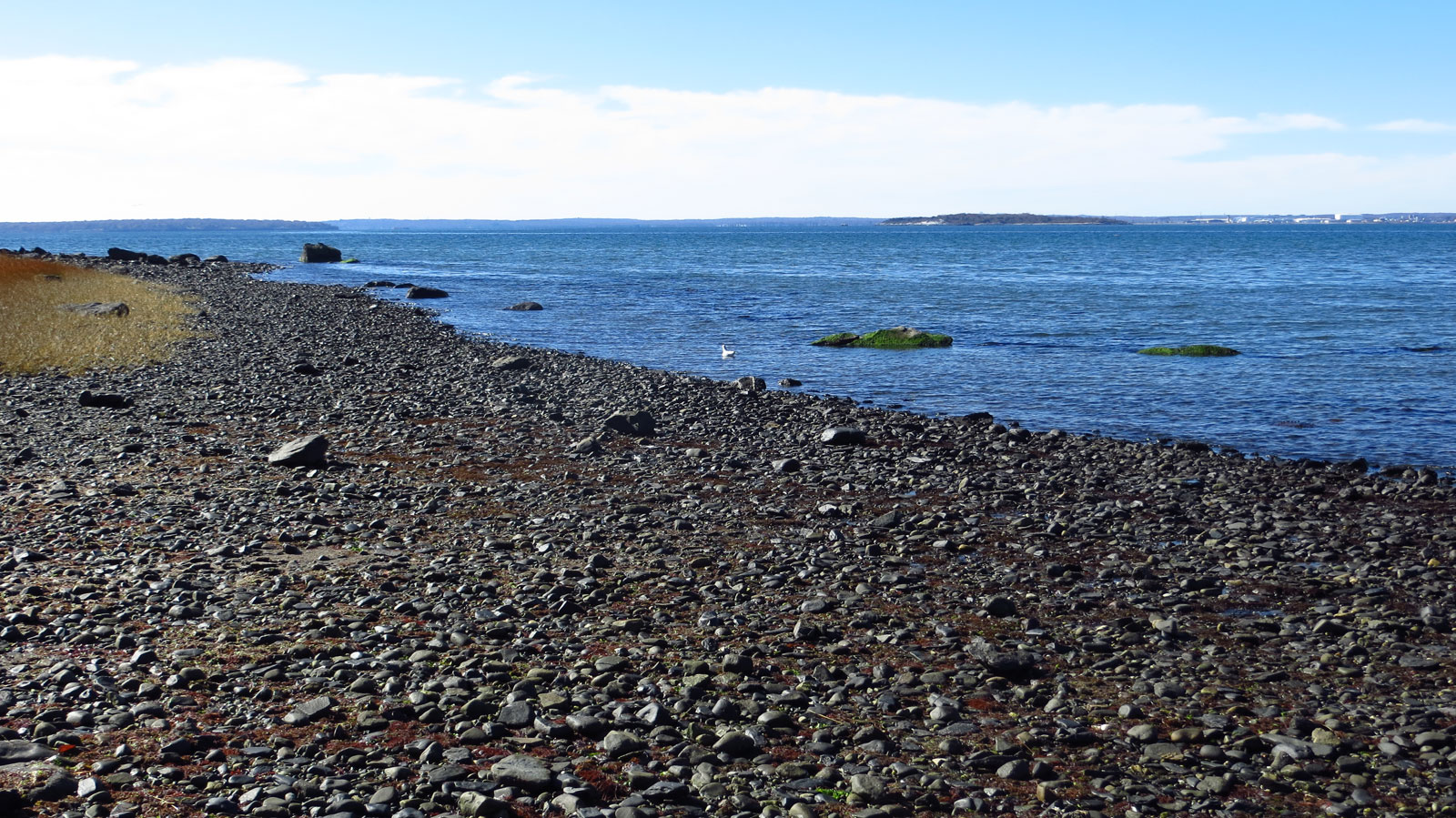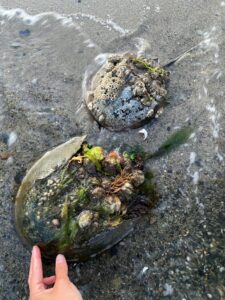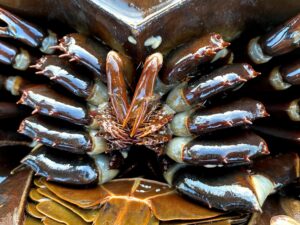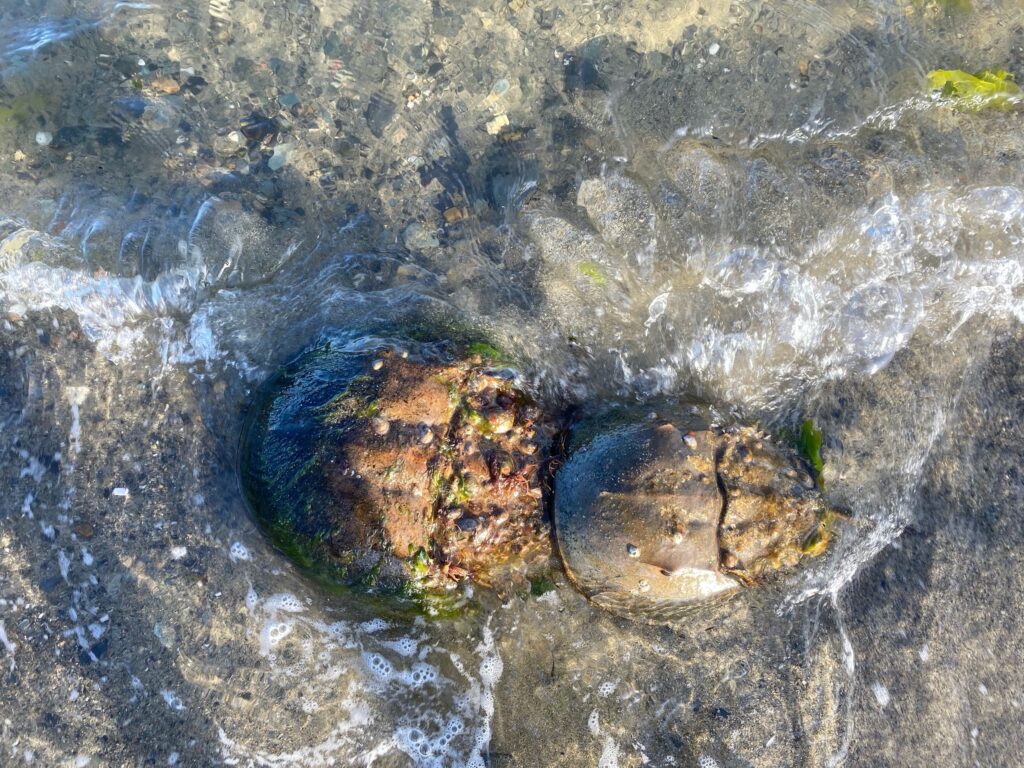 News
News
Capstone on the Bay
When I first sat down to figure out what my capstone project would be to fill in the last requirement for my degree in Marine Conservation and Policy at Stony Brook University (SBU), I felt overwhelmed with options. I was grateful to be offered a position as a Park Naturalist with Narragansett Bay National Estuarine Research Reserve (or NBNERR, for short) where I would be able to complete my capstone while working. The idea for which conservation project I would tackle came to me when I figured out the day I was relocating to the remote Prudence Island, that sits nestled in the geographic center of Narragansett Bay, June 1st – right in time for spawning Atlantic horseshoe crab (Limulus polyphemus) season.

with distinct size differences
Prudence Island is only accessible by ferry which runs on a limited schedule, making it difficult for researchers to stay long enough in order to actually monitor the spawning horseshoe crabs that come to shore during the evening high tides occurring during the full and new moon. I was lucky enough to live on Prudence Island during my time of work, and therefore had all the time I needed to monitor the spawning horseshoe crabs in order to get an idea of the populations that may utilize this island’s shorelines for laying eggs. I was also grateful to have a wonderful co-intern, Elizabeth, to help with data collection.
The misnamed “horseshoe crabs” are actually not crabs, rather they are more closely related to spiders and scorpions than their aquatic crustacean counterparts. Being closely related to organisms often associated with danger and poison doesn’t help the horseshoe crab’s reputation out when it pairs with their fierce looks – pointy tail, hard shell, lots of legs with pinchers. However, horseshoe crabs cannot hurt you, and in fact, they help save our lives. Their blood has an important enzyme in it that is used in vaccination development for humans. The biomedical industry will, in a similar way to how humans donate blood, hook up the horseshoe crabs and take their blood to extract this enzyme. If you thought that was the only beneficial use of horseshoe crabs for humans, you’d be mistaken! They are also harvested for their use as bait within fisheries, primarily focused on eel and whelk fisheries (or conch, depending on your geographic name preference).
The popularity of horseshoe crabs within human cultures leaves them vulnerable to being exploited, removing too many before they have the chance to reach sexual maturity and reproduce. Luckily, there are many organizations across the Atlantic coast that monitor the spawning populations in order to inform law and policy makers on whether or not the populations need to be protected and set catch limits.

An additional aspect I included in my monitoring was the presence or not of the horseshoe crab’s obligate flatworm parasite, B. candida. Parasites are often thought of in a negative sense due to their undesirable effects upon their host and are widely ignored in ecological monitoring.
I believe if an organization is attempting to conserve a certain species, it is also important to consider its associated parasites. Since parasites range vastly in shape and size, parasites can also prove difficult to monitor. However, B. candida can be easily seen on the underside of horseshoe crabs, moving around on the shell and on the legs. Although the scientific community does not believe that B. candida causes harm to the horseshoe crabs, they do lay their eggs within the horseshoe crab’s gills. In large quantity, the eggs could potentially impair respiration. Unfortunately, there are just not enough studies done on the interactions between horseshoe crabs and B. candida.
Therefore, I set out to determine the spawning horseshoe crabs and answer some questions. First, I wanted to see if there was a decreasing population gradient as I monitored beaches geographically northward into Narragansett Bay, because if the horseshoe crabs are migrating into the bay from the Atlantic Ocean, there should be more individuals on the southern end of Prudence compared to the northern end. Secondly, I wanted to determine if male and females will be equally distributed across all sites, because if they are here to mate there should be (at least) both males and females equally present. Lastly, I wanted to determine if the prevalence of B. candida infection in all adults, regardless of sex or location is 100%, which supports previous monitoring efforts out of SBU where 100% prevalence in adults compared to 0% prevalence in juveniles.

My findings were limited- there weren’t that many horseshoe crabs! After a short panic about “oh no, what am I going to change my capstone to this last minute” I remembered that any data, even if it’s a lack thereof, still shows something. With the minimal numbers I found, I was able to get a better picture of how horseshoe crabs within Narragansett Bay utilized the variety of beaches on Prudence Island as well as the associated parasitic reactions with B. candida. First, it was not suggested that there is a decreasing northward gradient of individuals. By comparing data collected from beaches at various points across the north /south gradient, the numbers remained higher per night on the northern site compared to middle and southern island locations.
These findings are challenging because there is no other data here to compare to. When comparing other (undisclosed) locations within Narragansett Bay, the variations of horseshoe crabs present varies by a few hundred. Perhaps the horseshoe crabs do not utilize this central island as much as anticipated, or other outside factors (e.g. previously exploited, sediment preference, bathymetry) have an effect. An explanation for the lower prevalence of B. candida infestation numbers to other datasets is that the horseshoe crabs studied on Prudence are widely dispersed and not mating, making it more difficult to spread parasites via direct contact. My hopes are that this research can be continued in future years in order to gain a better understanding of the horseshoe crabs population range and the role that B. candida may play within the horseshoe crab’s life.